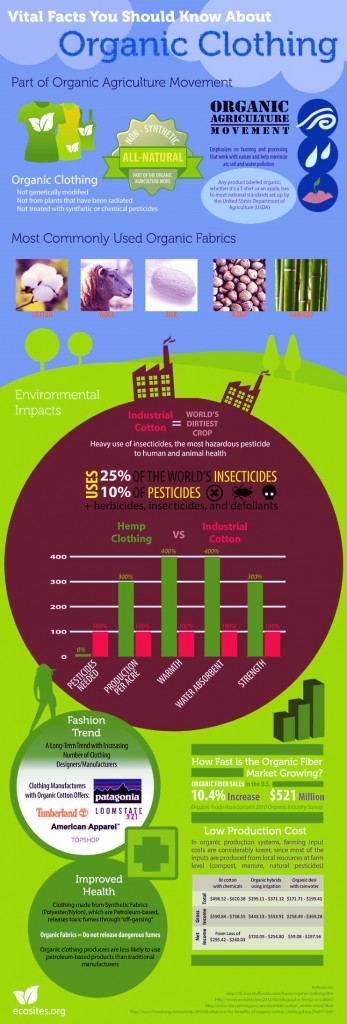by Suchi Rudra

Like the food we eat and the air we breathe, what we wear is an inextricable part of our every day lives. But whether we shop for simple, affordable garments or trendy outfits with a famous label, our clothes are actually chock full of chemicals that can be hazardous to our health.
Most of the clothing manufactured and purchased today around the world is made of synthetic materials, which contain surprisingly high levels of harmful chemicals and release volatile organic compounds (VOCs). The synthetic materials listed on our garment labels—rayon, polyester, nylon, spandex, acetate, etc–have only been around since the beginning of the 20th century. Before the use of chemicals to create these convenient and economic synthetic fabrics, people dressed themselves in all natural fibers, like cotton, wool, linen and silk.
Nylon and polyester, two of the most widely used synthetic fabrics today, are manufactured from petrochemicals, a process that not only emits high levels of pollution and contributes to global warming, but also results in non-biodegradable materials. Acrylic has been labeled by the EPA as possibly carcinogenic, while the manufacturing of rayon requires a cocktail of chemicals, including ammonia, acetoone and sulphuric acid.
Researchers at the nonprofit Ecology Center say that BFR exposure has been linked to “thyroid problems, learning and memory impairment, decreased fertility and behavioral changes.” Formaldehyde, which has been known to cause an increase in risk of lung cancer, is very commonly found in garments that have been treated to offer convenience and ease of use, and are labeled as stain-
free, wrinkle resistant, waterproof, anti-static or mildew resistant.
Investigations by Greenpeace last year found hazardous chemicals in clothing made with both artificial and natural materials (jeans, t-shirts, dresses, underwear) from 20 leading fashion brands. One of the key findings was that all tested brands had at least several items containing nonylphenol ethoxylates (NPEs), which break down into hormone-disrupting chemicals, with the highest concentrations in clothing items from Zara, Metersbonwe, Levi’s, C&A, Mango, Calvin Klein, Jack & Jones and Marks & Spencer. Other chemicals identified included high levels of toxic phthalates in four of the products, and traces of a cancer-causing amine from the use of certain azo dyes in two products from Zara. The presence of many other types of potentially hazardous industrial chemicals were found across many of the items tested.
 But even accessories are affected by chemical additives. A study last year of low cost children’s and adult jewelry by the Ecology Center also noted a “high level of concern” due to the presence of one or more hazardous chemicals detected at high levels. Four products contained over 10 percent cadmium, a known carcinogen. Fifty percent contained lead, with over half of these containing more than 100 ppm of lead in one or more components, exceeding the Consumer Product Safety Commission limit of lead in children’s products.
But even accessories are affected by chemical additives. A study last year of low cost children’s and adult jewelry by the Ecology Center also noted a “high level of concern” due to the presence of one or more hazardous chemicals detected at high levels. Four products contained over 10 percent cadmium, a known carcinogen. Fifty percent contained lead, with over half of these containing more than 100 ppm of lead in one or more components, exceeding the Consumer Product Safety Commission limit of lead in children’s products.
From the manufacturing process to the transportation of the finished garment, all clothing today, whether synthetic or natural, undergoes some kind of chemical treatment. In a National Resources Defense Council report entitled “Clean by Design,” it was stated that “Textile manufacturing has a huge environmental footprint, polluting as much as 200 tons of water per ton of fabric with a suite of harmful chemicals.”
Organic fashion, a sub-category of the popular eco-fashion movement, limits or almost entirely eliminates the use of chemicals in the production of clothing and accessories. Wearing organic garments, garments made from natural fibers and those without synthetic dyes that release toxic chemicals can greatly reduce any potential health risks. Other healthier fabrics to try include organic bamboo and wool, jute, linen, silk hemp and silk modal (made from sustainably harvested beech trees).
Take a moment to go through your wardrobe and read the labels. If you’re seeing a pattern of synthetic materials, it might be time to rethink your shopping strategy for the sake of your health.
Asian Fortune is an English language newspaper for Asian American professionals in the Washington, DC metropolitan area. Visit fb.com/asianfortune to stay up to date with our news and what’s going on in the Asian American community.
 Asian Fortune Your source for all things Asian American
Asian Fortune Your source for all things Asian American



